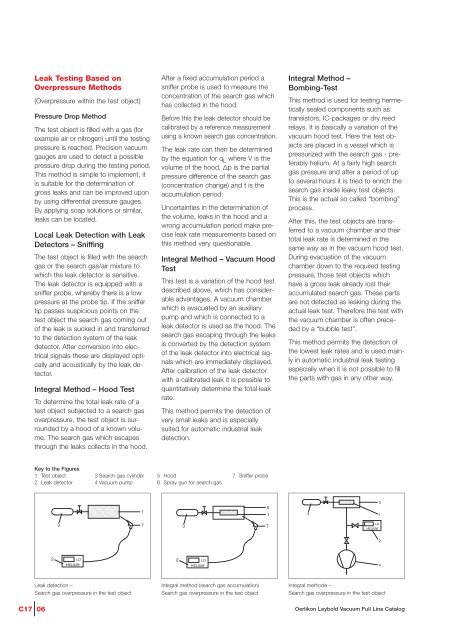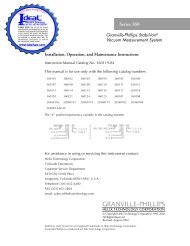Leak Testing Instruments - Vacuum Products Canada Inc.
Leak Testing Instruments - Vacuum Products Canada Inc.
Leak Testing Instruments - Vacuum Products Canada Inc.
Create successful ePaper yourself
Turn your PDF publications into a flip-book with our unique Google optimized e-Paper software.
<strong>Leak</strong> <strong>Testing</strong> Based on<br />
Overpressure Methods<br />
(Overpressure within the test object)<br />
Pressure Drop Method<br />
The test object is filled with a gas (for<br />
example air or nitrogen) until the testing<br />
pressure is reached. Precision vacuum<br />
gauges are used to detect a possible<br />
pressure drop during the testing period.<br />
This method is simple to implement, it<br />
is suitable for the determination of<br />
gross leaks and can be improved upon<br />
by using differential pressure gauges.<br />
By applying soap solutions or similar,<br />
leaks can be located.<br />
Local <strong>Leak</strong> Detection with <strong>Leak</strong><br />
Detectors – Sniffing<br />
The test object is filled with the search<br />
gas or the search gas/air mixture to<br />
which the leak detector is sensitive.<br />
The leak detector is equipped with a<br />
sniffer probe, whereby there is a low<br />
pressure at the probe tip. If the sniffer<br />
tip passes suspicious points on the<br />
test object the search gas coming out<br />
of the leak is sucked in and transferred<br />
to the detection system of the leak<br />
detector. After conversion into electrical<br />
signals these are displayed optically<br />
and acoustically by the leak detector.<br />
Integral Method – Hood Test<br />
To determine the total leak rate of a<br />
test object subjected to a search gas<br />
overpressure, the test object is surrounded<br />
by a hood of a known volume.<br />
The search gas which escapes<br />
through the leaks collects in the hood.<br />
After a fixed accumulation period a<br />
sniffer probe is used to measure the<br />
concentration of the search gas which<br />
has collected in the hood.<br />
Before this the leak detector should be<br />
calibrated by a reference measurement<br />
using a known search gas concentration.<br />
The leak rate can then be determined<br />
by the equation for q L where V is the<br />
volume of the hood, Vp is the partial<br />
pressure difference of the search gas<br />
(concentration change) and t is the<br />
accumulation period.<br />
Uncertainties in the determination of<br />
the volume, leaks in the hood and a<br />
wrong accumulation period make precise<br />
leak rate measurements based on<br />
this method very questionable.<br />
Integral Method – <strong>Vacuum</strong> Hood<br />
Test<br />
This test is a variation of the hood test<br />
described above, which has considerable<br />
advantages. A vacuum chamber<br />
which is evacuated by an auxiliary<br />
pump and which is connected to a<br />
leak detector is used as the hood. The<br />
search gas escaping through the leaks<br />
is converted by the detection system<br />
of the leak detector into electrical signals<br />
which are immediately displayed.<br />
After calibration of the leak detector<br />
with a calibrated leak it is possible to<br />
quantitatively determine the total leak<br />
rate.<br />
This method permits the detection of<br />
very small leaks and is especially<br />
suited for automatic industrial leak<br />
detection.<br />
Integral Method –<br />
Bombing-Test<br />
This method is used for testing hermetically<br />
sealed components such as<br />
transistors, IC-packages or dry reed<br />
relays. It is basically a variation of the<br />
vacuum hood test. Here the test objects<br />
are placed in a vessel which is<br />
pressurized with the search gas - preferably<br />
helium. At a fairly high search<br />
gas pressure and after a period of up<br />
to several hours it is tried to enrich the<br />
search gas inside leaky test objects.<br />
This is the actual so called “bombing”<br />
process.<br />
After this, the test objects are transferred<br />
to a vacuum chamber and their<br />
total leak rate is determined in the<br />
same way as in the vacuum hood test.<br />
During evacuation of the vacuum<br />
chamber down to the required testing<br />
pressure, those test objects which<br />
have a gross leak already lost their<br />
accumulated search gas. These parts<br />
are not detected as leaking during the<br />
actual leak test. Therefore the test with<br />
the vacuum chamber is often preceded<br />
by a “bubble test”.<br />
This method permits the detection of<br />
the lowest leak rates and is used mainly<br />
in automatic industrial leak testing<br />
especially when it is not possible to fill<br />
the parts with gas in any other way.<br />
Key to the Figures<br />
1 Test object 3 Search gas cylinder 5 Hood 7 Sniffer probe<br />
2 <strong>Leak</strong> detector 4 <strong>Vacuum</strong> pump 6 Spray gun for search gas<br />
1<br />
5<br />
1<br />
3<br />
5<br />
1<br />
3<br />
7<br />
3<br />
7<br />
LD<br />
HELIUM<br />
2<br />
2<br />
LD<br />
HELIUM<br />
2<br />
LD<br />
HELIUM<br />
4<br />
<strong>Leak</strong> detection –<br />
Search gas overpressure in the test object<br />
Integral method (search gas accumulation)<br />
Search gas overpressure in the test object<br />
Integral methode –<br />
Search gas overpressure in the test object<br />
C17 06<br />
Oerlikon Leybold <strong>Vacuum</strong> Full Line Catalog

















